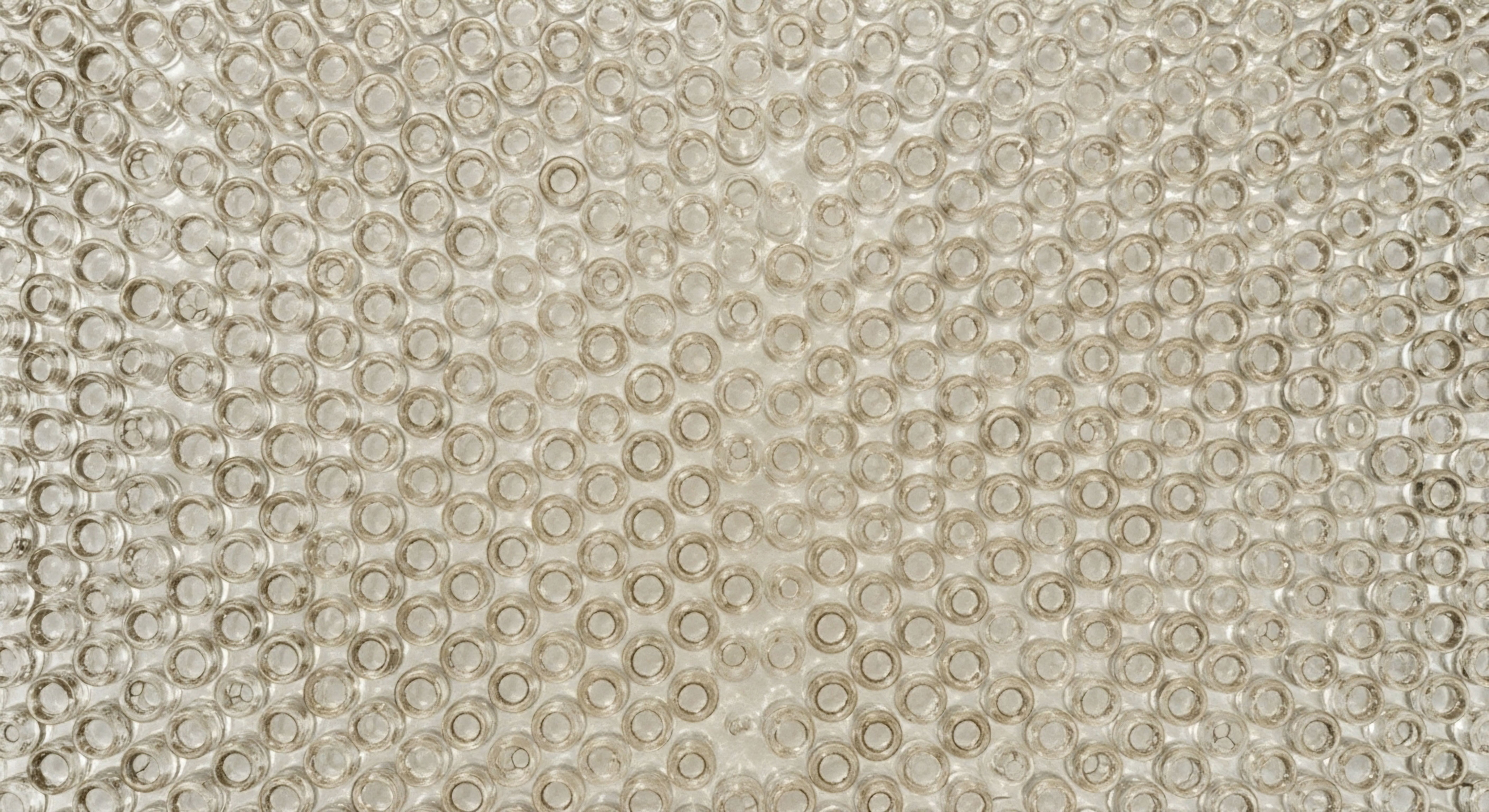

Fundamentals
Experiencing changes in hair density or texture can feel disorienting, a subtle yet persistent signal that something within your biological systems may be shifting. Many individuals describe a sense of quiet alarm when they notice more strands on their pillow or a widening part, recognizing these observations as more than just cosmetic concerns.
This experience often prompts a deeper inquiry into what their body is communicating. It is a deeply personal journey, one that speaks to the intimate connection between our outward appearance and the intricate, often unseen, processes governing our internal physiology. Understanding these signals, particularly as they relate to hormonal balance, represents a significant step toward reclaiming vitality and function.
The endocrine system, a sophisticated network of glands and organs, orchestrates a symphony of chemical messengers known as hormones. These potent biochemicals circulate throughout the body, influencing virtually every cellular process, from metabolism and mood to reproductive function and, indeed, hair growth.
When this delicate balance is disrupted, the effects can manifest in various ways, including alterations in hair health. Recognizing the profound impact of these internal messengers on your physical presentation provides a powerful lens through which to view your overall well-being.
Hair health provides a visible barometer for the body’s internal hormonal equilibrium.

The Endocrine System and Hair Follicle Biology
Hair follicles, the miniature organs responsible for producing hair, are remarkably sensitive to hormonal fluctuations. Each follicle undergoes a cyclical process of growth (anagen), regression (catagen), and rest (telogen). The duration of these phases, particularly the anagen phase, dictates hair length and density. Hormones act as critical regulators of this cycle, influencing cellular proliferation, differentiation, and programmed cell death within the follicle.
Androgens, a class of hormones including testosterone and dihydrotestosterone (DHT), play a particularly prominent role in hair health. While often associated with male characteristics, androgens are present in both men and women and are essential for various physiological functions.
In certain predisposed individuals, an excess or heightened sensitivity to androgens can lead to follicular miniaturization, a process where hair follicles shrink over time, producing progressively finer and shorter hairs until they cease production entirely. This phenomenon is a hallmark of androgenetic alopecia, a common form of hair thinning.
Estrogens, primarily estradiol, also exert significant influence on hair growth. In women, adequate estrogen levels typically support a longer anagen phase, contributing to thicker, healthier hair. Fluctuations in estrogen, such as those experienced during perimenopause or postpartum periods, can lead to increased hair shedding as follicles prematurely enter the telogen phase. The interplay between estrogens and androgens within the hair follicle is complex, involving local enzymatic conversions and receptor binding.

Beyond Androgens and Estrogens
The thyroid hormones, thyroxine (T4) and triiodothyronine (T3), are fundamental regulators of metabolic rate and cellular activity throughout the body, including the hair follicles. Both hypothyroidism (underactive thyroid) and hyperthyroidism (overactive thyroid) can disrupt the hair growth cycle, leading to diffuse hair loss. Thyroid hormone receptors are present in hair follicle cells, indicating their direct role in regulating follicular function and hair shaft formation.
Cortisol, often termed the “stress hormone,” is released by the adrenal glands in response to physical or psychological stressors. While essential for acute stress responses, chronically elevated cortisol levels can have detrimental effects on various bodily systems, including hair. Sustained high cortisol can shift hair follicles into a resting phase, leading to increased shedding. The intricate connection between the hypothalamic-pituitary-adrenal (HPA) axis and the hair growth cycle underscores the systemic impact of stress on hair vitality.
Insulin, a peptide hormone central to glucose metabolism, also influences hair health. Insulin resistance, a condition where cells become less responsive to insulin, can contribute to hormonal imbalances, particularly increasing androgen production in women. This metabolic dysregulation can indirectly affect hair follicles, contributing to thinning patterns seen in conditions like polycystic ovary syndrome (PCOS).

Understanding Hormonal Balance and Hair
The concept of hormonal balance extends beyond simply measuring individual hormone levels. It encompasses the intricate feedback loops, receptor sensitivities, and enzymatic conversions that dictate how hormones are produced, transported, and utilized at the cellular level. Hair health provides a tangible reflection of this internal equilibrium. When individuals experience hair changes, it prompts a valuable opportunity to investigate the underlying hormonal landscape.
Considering your own biological systems as a dynamic, interconnected network is essential. Hair thinning or loss is rarely an isolated event; it often signals broader systemic considerations. Addressing these underlying hormonal and metabolic factors through non-pharmacological strategies offers a path toward restoring not only hair vitality but also overall well-being. This approach acknowledges the body’s innate capacity for self-regulation when provided with the appropriate support.


Intermediate
Addressing hair health during hormonal optimization requires a comprehensive strategy that extends beyond isolated interventions. It involves understanding how various non-pharmacological approaches can modulate endocrine function and support follicular vitality. This section details specific clinical protocols and lifestyle adjustments that can significantly influence hair growth and density by recalibrating the body’s internal messaging systems.

Nutritional Foundations for Follicular Support
The building blocks for healthy hair are derived directly from the diet. Nutritional deficiencies can profoundly impact hair follicle function, leading to compromised hair structure and growth. A balanced intake of macronutrients ∞ proteins, healthy fats, and complex carbohydrates ∞ provides the necessary energy and raw materials for keratin synthesis, the primary protein composing hair.
Micronutrients play equally vital roles. Iron deficiency, even without overt anemia, is a common contributor to hair shedding, particularly in women. Iron is essential for oxygen transport to the hair follicles and for the activity of enzymes involved in hair growth. Zinc is another critical mineral, participating in numerous enzymatic reactions within the hair follicle and influencing protein synthesis. Zinc deficiency can lead to hair loss and impaired hair shaft quality.
B vitamins, especially biotin, folate, and B12, are cofactors in metabolic pathways essential for cell growth and division, including those in rapidly proliferating hair follicle cells. While biotin deficiency is rare, adequate intake supports keratin infrastructure. Vitamin D, increasingly recognized as a hormone, has receptors in hair follicles and plays a role in initiating and maintaining the anagen phase. Insufficient vitamin D levels have been linked to various forms of hair loss.
Targeted nutritional support provides the essential raw materials for robust hair follicle function.
Consider the following nutritional components for hair health:
- Protein ∞ Adequate intake of complete proteins, providing all essential amino acids, is fundamental for keratin production. Sources include lean meats, fish, eggs, legumes, and quinoa.
- Iron ∞ Rich sources include red meat, lentils, spinach, and fortified cereals. Pairing iron-rich foods with vitamin C sources enhances absorption.
- Zinc ∞ Found in oysters, beef, pumpkin seeds, and lentils.
- B Vitamins ∞ Present in whole grains, leafy greens, eggs, and meat.
- Vitamin D ∞ Obtained through sun exposure, fatty fish, and fortified foods. Supplementation may be necessary, guided by blood tests.
- Omega-3 Fatty Acids ∞ Anti-inflammatory properties support scalp health and overall cellular function. Sources include fatty fish, flaxseeds, and walnuts.

Stress Modulating Protocols and Hair Health
Chronic stress triggers a cascade of physiological responses, primarily through the HPA axis, leading to sustained elevation of cortisol. This prolonged cortisol exposure can disrupt the hair growth cycle, pushing follicles prematurely into the telogen (resting) phase, resulting in increased shedding known as telogen effluvium. Managing stress effectively is a cornerstone of non-pharmacological hair support.
Mind-body practices offer powerful tools for stress reduction. Techniques such as meditation, deep breathing exercises, and mindfulness can help regulate the autonomic nervous system, shifting the body from a “fight or flight” sympathetic state to a “rest and digest” parasympathetic state. Regular engagement with these practices can lower circulating cortisol levels, thereby supporting a healthier hair growth cycle.
Physical activity also serves as a potent stress modulator. Regular, moderate exercise helps metabolize stress hormones and promotes the release of endorphins, which have mood-elevating effects. The type and intensity of exercise should be tailored to individual capacity, prioritizing consistency over strenuous exertion.

Sleep Optimization and Hormonal Rhythm
Sleep is not merely a period of rest; it is a vital time for cellular repair, hormonal synthesis, and metabolic regulation. Disrupted sleep patterns can dysregulate circadian rhythms, which in turn affect the pulsatile release of various hormones, including growth hormone and cortisol. Insufficient or poor-quality sleep can contribute to chronic stress, insulin resistance, and inflammation, all of which can indirectly impact hair health.
Establishing a consistent sleep schedule, creating a conducive sleep environment, and avoiding stimulants before bedtime are practical steps toward optimizing sleep. Aiming for 7-9 hours of quality sleep each night supports the body’s natural restorative processes and helps maintain hormonal equilibrium, which is beneficial for hair follicles.

Targeted Supplementation Strategies
While a nutrient-dense diet forms the foundation, targeted supplementation can address specific deficiencies or support particular physiological pathways relevant to hair health. These should always be guided by clinical assessment and laboratory testing.
Certain peptides, while often discussed in the context of growth hormone therapy, also hold relevance for tissue repair and cellular regeneration, which can indirectly benefit hair follicles. For instance, peptides like Sermorelin or Ipamorelin / CJC-1295, by stimulating the natural release of growth hormone, can promote cellular turnover and improve overall tissue vitality. Growth hormone itself has anabolic effects that can support the health of rapidly dividing cells, including those in hair follicles.
Another peptide, Pentadeca Arginate (PDA), is recognized for its tissue repair and anti-inflammatory properties. Reducing systemic inflammation can create a more favorable environment for hair growth, as chronic inflammation can contribute to follicular damage and miniaturization.
A comparative overview of non-pharmacological strategies:
| Strategy | Primary Mechanism of Action | Direct Hair Benefit |
|---|---|---|
| Nutritional Optimization | Provides essential building blocks and cofactors for cellular function and keratin synthesis. | Improved hair structure, reduced shedding, enhanced growth. |
| Stress Modulating Practices | Regulates HPA axis, lowers cortisol, shifts autonomic balance. | Reduced telogen effluvium, healthier growth cycle. |
| Sleep Optimization | Supports circadian rhythm, hormone synthesis, cellular repair. | Improved overall hormonal balance, reduced systemic stress. |
| Targeted Supplementation | Addresses specific deficiencies, supports growth factors, reduces inflammation. | Enhanced follicular activity, improved hair density. |
These non-pharmacological strategies are not isolated interventions; they are interconnected components of a holistic approach to hormonal optimization and hair health. Integrating these practices into a personalized wellness protocol can create a synergistic effect, supporting the body’s innate capacity for balance and regeneration.


Academic
A deep understanding of non-pharmacological strategies for hair health during hormonal optimization necessitates a rigorous examination of the underlying molecular and cellular mechanisms. This academic exploration moves beyond superficial connections, delving into the intricate signaling pathways, enzymatic conversions, and cellular dynamics that govern hair follicle behavior in response to systemic hormonal cues. The objective is to elucidate how targeted interventions can modulate these complex biological axes to support robust hair growth.

Androgen Receptor Sensitivity and Enzymatic Conversions
The impact of androgens on hair follicles is not solely determined by circulating hormone levels; it is profoundly influenced by local enzymatic activity and receptor sensitivity within the follicular unit. The enzyme 5-alpha reductase, particularly its type 2 isoform, converts testosterone into the more potent androgen, dihydrotestosterone (DHT).
DHT binds with high affinity to androgen receptors located in the dermal papilla cells of genetically predisposed hair follicles. This binding initiates a cascade of events leading to follicular miniaturization, a hallmark of androgenetic alopecia.
Non-pharmacological approaches can influence this pathway. Certain dietary compounds, such as epigallocatechin gallate (EGCG) found in green tea, and saw palmetto extracts, have been investigated for their potential to inhibit 5-alpha reductase activity. While the clinical efficacy of these natural inhibitors varies and requires further robust research, the mechanistic premise is to reduce local DHT concentrations, thereby mitigating its miniaturizing effects on susceptible follicles.
Conversely, the enzyme aromatase converts androgens into estrogens. In some hair follicles, particularly those on the scalp, aromatase activity can protect against androgen-induced miniaturization by reducing local androgen levels and increasing estrogenic influence. Understanding the balance between 5-alpha reductase and aromatase activity within the follicle provides a sophisticated perspective on hair health regulation.
Hair follicle response to hormones is governed by a delicate balance of local enzymatic activity and receptor sensitivity.

The Hypothalamic-Pituitary-Gonadal (HPG) Axis and Hair Signaling
The HPG axis represents a central neuroendocrine pathway regulating reproductive hormones, but its influence extends to systemic well-being, including hair health. The hypothalamus releases gonadotropin-releasing hormone (GnRH), which stimulates the pituitary gland to secrete luteinizing hormone (LH) and follicle-stimulating hormone (FSH). These gonadotropins, in turn, regulate gonadal hormone production (testosterone in testes, estrogens and progesterone in ovaries).
Disruptions in the HPG axis, such as those seen in chronic stress or metabolic dysregulation, can alter the pulsatile release of GnRH, subsequently affecting LH and FSH levels and downstream gonadal hormone production. For instance, chronic stress can suppress GnRH release, leading to lower testosterone levels in men or irregular cycles in women, which can indirectly impact hair health.
Peptide therapies, such as Gonadorelin, which mimics natural GnRH, can be employed to support the HPG axis. In men, Gonadorelin can stimulate endogenous LH and FSH production, thereby supporting natural testosterone synthesis and testicular function.
This approach can be particularly relevant for men discontinuing exogenous testosterone replacement therapy (TRT) or those seeking to maintain fertility, as it aims to restore the body’s intrinsic hormonal signaling rather than replacing hormones directly. By supporting the foundational HPG axis, a more balanced hormonal milieu is created, which can positively influence hair follicle vitality.

Metabolic Interplay and Follicular Health
The connection between metabolic health and hair follicles is increasingly recognized. Insulin resistance and chronic low-grade inflammation can significantly impact hormonal balance and cellular function within the hair follicle. Hyperinsulinemia, often accompanying insulin resistance, can stimulate ovarian androgen production in women, contributing to hyperandrogenism and subsequent hair thinning patterns.
Dietary interventions, such as reducing refined carbohydrates and promoting a balanced intake of healthy fats and proteins, can improve insulin sensitivity. This metabolic recalibration can indirectly reduce androgen excess and create a more favorable environment for hair growth. Furthermore, anti-inflammatory dietary components, such as omega-3 fatty acids and antioxidants, can mitigate systemic inflammation that might otherwise compromise follicular integrity.
The role of the microbiome, particularly the gut microbiome, in modulating systemic inflammation and nutrient absorption also warrants consideration. A healthy gut microbiome contributes to overall metabolic health, which in turn supports hormonal balance and nutrient delivery to hair follicles.

Growth Factors and Cellular Signaling in Hair Follicles
Hair follicle growth is regulated by a complex interplay of various growth factors and signaling molecules. These include insulin-like growth factor 1 (IGF-1), vascular endothelial growth factor (VEGF), and fibroblast growth factors (FGFs). These factors promote cellular proliferation, angiogenesis (blood vessel formation), and overall follicular activity.
Growth hormone peptide therapy, utilizing agents like Sermorelin or Ipamorelin / CJC-1295, stimulates the pituitary gland to release endogenous growth hormone. Growth hormone, in turn, stimulates the liver to produce IGF-1. Elevated IGF-1 levels can have anabolic effects on various tissues, including hair follicles, potentially extending the anagen phase and promoting hair shaft thickness. This represents a sophisticated non-pharmacological strategy to enhance the body’s intrinsic growth-promoting pathways.
The intricate network of signaling pathways within the hair follicle, influenced by systemic hormones, metabolic status, and local growth factors, underscores the complexity of hair health. Non-pharmacological strategies, when applied with a deep understanding of these biological mechanisms, offer a powerful means to support hair vitality by recalibrating the body’s internal systems.
A deeper look at hormonal influences on hair cycle phases:
| Hormone/Factor | Influence on Hair Cycle | Mechanism of Action |
|---|---|---|
| Androgens (DHT) | Shortens anagen, accelerates telogen. | Binds to androgen receptors in dermal papilla, causing miniaturization. |
| Estrogens | Prolongs anagen, delays telogen. | Supports follicular proliferation, counteracts androgen effects. |
| Thyroid Hormones (T3, T4) | Regulates metabolic rate of follicles. | Directly influences follicular cell metabolism and growth. |
| Cortisol | Induces premature telogen entry. | Disrupts follicular stem cell activity, increases inflammatory cytokines. |
| Insulin/IGF-1 | Promotes anagen, cellular proliferation. | Activates growth pathways in follicular cells. |

Can Nutritional Deficiencies Directly Cause Hair Thinning?
Yes, specific nutritional deficiencies can directly impair hair follicle function and lead to hair thinning or loss. For instance, a significant lack of iron can result in diffuse hair shedding because iron is essential for the activity of enzymes involved in hair growth and for oxygen delivery to the follicles.
Similarly, inadequate zinc intake can compromise the structural integrity of hair and disrupt the hair growth cycle, as zinc is a cofactor for numerous enzymes critical to follicular health. These deficiencies directly impact the cellular processes required for robust hair production.

References
- Whiting, David A. “Androgenetic alopecia ∞ an update.” Clinics in Dermatology, vol. 19, no. 2, 2001, pp. 165-175.
- Trueb, Ralph M. “Pharmacologic interventions in hair diseases.” Clinics in Dermatology, vol. 24, no. 5, 2006, pp. 386-397.
- Giacomoni, Paolo U. and Gianfranco F. Giacomoni. “The hair follicle ∞ a model for studying the effects of hormones on human skin.” Journal of Steroid Biochemistry and Molecular Biology, vol. 102, no. 1-5, 2006, pp. 216-220.
- Guo, Edward L. and Rajani Katta. “Diet and hair loss ∞ effects of nutrient deficiency and supplement use.” Dermatology Practical & Conceptual, vol. 7, no. 1, 2017, pp. 1-10.
- Harrison, Susan, and Rodney Sinclair. “Telogen effluvium.” Clinical and Experimental Dermatology, vol. 34, no. 8, 2009, pp. 987-993.
- Oh, Jin-Woo, et al. “Role of vitamin D in hair loss ∞ A systematic review.” Journal of Cosmetic Dermatology, vol. 20, no. 1, 2021, pp. 29-35.
- Messenger, Alan G. and David A. Rundegren. “Androgenetic alopecia ∞ new insights into the pathogenesis and genetic predisposition.” Drug Discovery Today ∞ Disease Mechanisms, vol. 1, no. 2, 2004, pp. 139-145.
- Chen, W. “The role of growth hormone and insulin-like growth factor-1 in hair growth.” Growth Hormone & IGF Research, vol. 17, no. 1, 2007, pp. 1-9.
- Paus, Ralf, and George Cotsarelis. “The biology of hair follicles.” The New England Journal of Medicine, vol. 341, no. 7, 1999, pp. 491-497.
- Stough, Clyde, et al. “The effect of 5-alpha reductase inhibitors on hair growth ∞ a review.” Journal of Drugs in Dermatology, vol. 12, no. 10, 2013, pp. 1139-1144.

Reflection
Your personal health journey is a dynamic process, a continuous dialogue between your biological systems and the choices you make each day. The insights gained regarding hormonal health and its connection to hair vitality serve as a powerful starting point. This knowledge is not an endpoint; it is an invitation to engage more deeply with your own physiology. Understanding the intricate mechanisms at play empowers you to make informed decisions, moving beyond a reactive stance to one of proactive recalibration.
Consider this information a lens through which to view your unique biological blueprint. The path to reclaiming vitality and optimal function is highly individualized, requiring careful consideration of your specific hormonal landscape, metabolic markers, and lifestyle patterns.
This journey involves a commitment to self-observation, a willingness to adjust, and the recognition that true well-being arises from a harmonious interplay of internal and external factors. Your body possesses an innate intelligence; providing it with the right support allows that intelligence to express itself fully.

How Can Lifestyle Choices Influence Hormonal Balance?
Lifestyle choices significantly influence hormonal balance by affecting various physiological systems. Dietary patterns, for instance, directly impact insulin sensitivity and inflammation, which in turn modulate androgen and estrogen metabolism. Regular physical activity can improve insulin signaling and reduce chronic stress, thereby supporting a more balanced hormonal profile. Sleep quality also plays a critical role, as disrupted sleep can dysregulate circadian rhythms and the pulsatile release of essential hormones. These daily habits collectively shape the endocrine environment.



